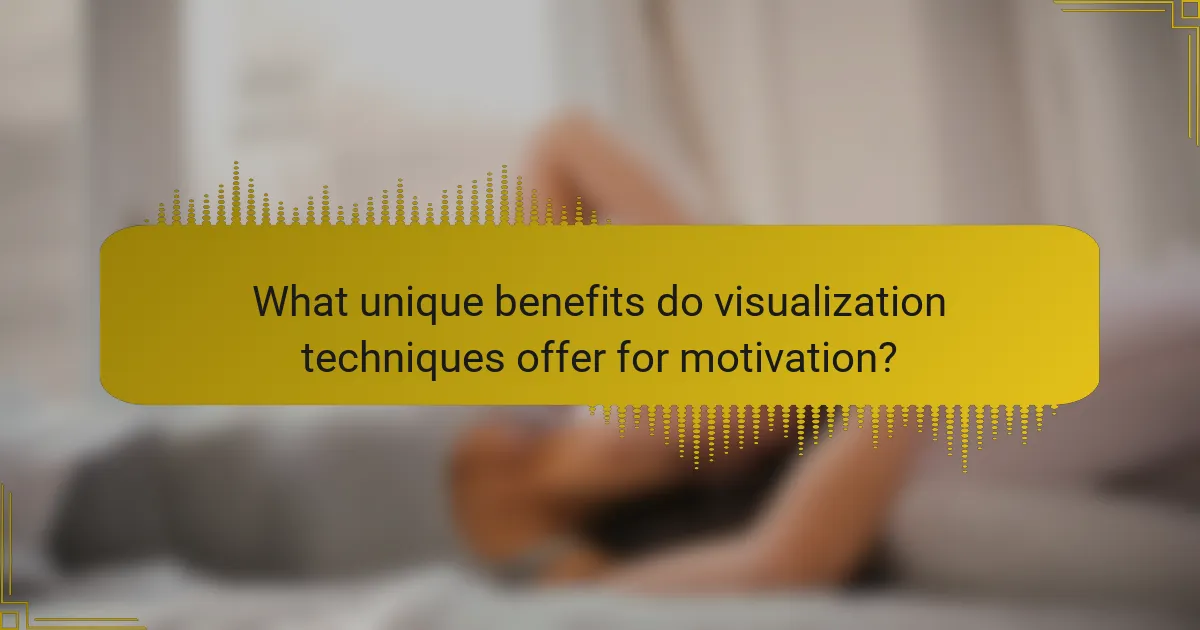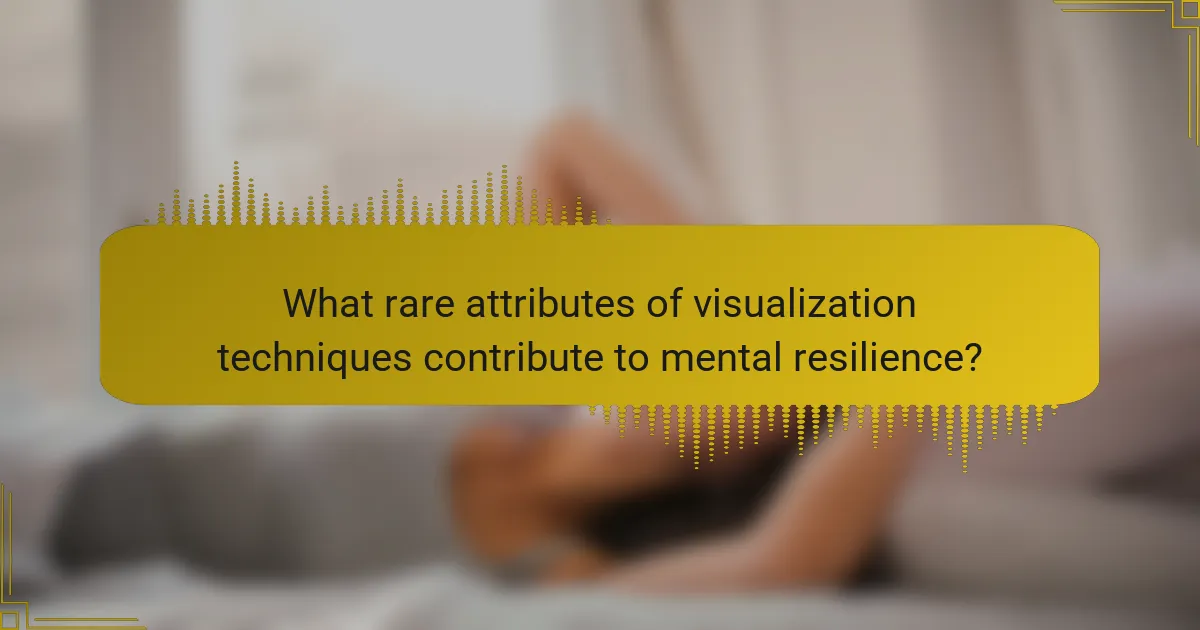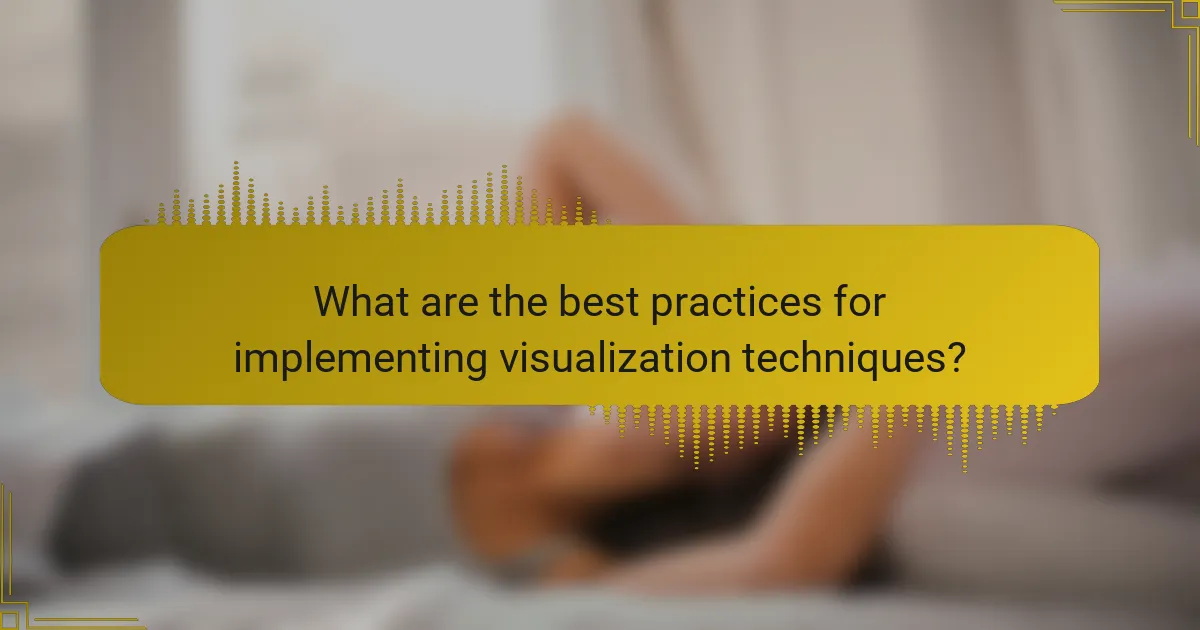Visualization techniques can significantly enhance performance, motivation, and mental resilience. Key approaches include goal setting to align objectives, progress tracking for immediate feedback, data visualization for clarity, and mindfulness imagery to overcome challenges. These methods provide clarity, boost confidence, and foster emotional regulation, ultimately empowering individuals to achieve their goals and maintain focus. Implementing these techniques effectively requires clarity, engagement, and regular assessment of their impact on performance.

What are the core visualization techniques for performance improvement?
Effective visualization techniques enhance performance improvement by providing clarity and motivation. Key techniques include goal setting, progress tracking, data visualization, and mindfulness imagery.
Goal setting aligns individual objectives with visual cues, fostering motivation. Progress tracking through charts or graphs allows for immediate feedback, reinforcing positive behavior. Data visualization transforms complex information into accessible formats, aiding comprehension and decision-making. Mindfulness imagery promotes mental resilience by visualizing success and overcoming challenges.
These techniques collectively empower individuals to enhance their performance and maintain motivation.
How does visualization enhance athletic performance?
Visualization techniques significantly enhance athletic performance by improving focus, motivation, and mental resilience. Athletes who regularly practice visualization can mentally rehearse their skills, leading to better execution during competition. This technique fosters a strong mind-body connection, enabling athletes to manage stress and anxiety effectively.
Research indicates that visualization can increase performance by up to 45% in specific sports. Athletes visualize successful outcomes, which builds confidence and reinforces positive mental states. This practice also aids in injury recovery by allowing athletes to mentally engage with their sport, maintaining a connection to their physical abilities.
Incorporating visualization into training routines can be a unique attribute of elite athletes. They often use detailed imagery, envisioning every aspect of their performance, from technique to emotional state. This rare attribute sets them apart, as it cultivates a mindset geared toward success, ultimately enhancing overall athletic performance.
What role does visualization play in workplace productivity?
Visualization techniques significantly enhance workplace productivity by improving focus and motivation. These techniques help individuals clarify goals, track progress, and foster mental resilience. For example, visualizing tasks can reduce overwhelm, making it easier to prioritize and execute effectively. Studies show that employees who utilize visualization report higher engagement and lower stress levels, leading to improved performance and job satisfaction.
What are effective visualization exercises for professionals?
Visualization techniques enhance performance, motivation, and mental resilience. Effective exercises include guided imagery, where professionals visualize success scenarios; mindfulness meditation, which fosters present-moment awareness; and vision boards, helping to clarify goals visually. Additionally, mental rehearsal allows individuals to practice skills mentally, improving confidence and execution. These techniques build mental strength, promoting a positive mindset and goal achievement.
How can athletes incorporate visualization into their training routines?
Athletes can incorporate visualization into their training routines by regularly practicing mental imagery exercises. This technique enhances performance, boosts motivation, and builds mental resilience.
One effective method is to visualize specific skills or scenarios before executing them, which can improve muscle memory and confidence. Athletes can set aside time during training sessions to close their eyes and imagine successful performances, focusing on sensory details like sights, sounds, and feelings associated with the experience.
Additionally, creating a vision board with images and affirmations can serve as a daily reminder of goals, reinforcing positive mental states. Engaging in guided imagery sessions, either alone or with a coach, can also provide structured support for integrating visualization into routine training.

What unique benefits do visualization techniques offer for motivation?
Visualization techniques enhance motivation by creating vivid mental images of desired outcomes. These techniques improve focus, boost confidence, and foster a positive mindset. By vividly imagining success, individuals can reduce anxiety and increase resilience. Research indicates that visualization can lead to improved performance, as athletes and professionals harness these mental strategies to achieve their goals. The unique benefit lies in its ability to transform abstract aspirations into tangible mental representations, making motivation more accessible and actionable.
How can visualization boost self-confidence?
Visualization techniques can significantly boost self-confidence by enhancing mental imagery and focus. These techniques allow individuals to mentally rehearse their performance, which prepares them for real-life situations. As a result, visualization fosters a sense of control and readiness, leading to improved self-esteem.
Practicing visualization can create a strong mental framework. Athletes often use this method to envision successful outcomes, which can translate into actual performance improvements. Research indicates that vivid imagery activates similar brain regions as physical practice, reinforcing skills and confidence.
Additionally, visualization can reduce anxiety. By imagining positive scenarios, individuals can counteract negative thoughts and feelings of self-doubt. This mental preparation builds resilience, enabling individuals to face challenges with greater assurance.
Incorporating visualization into daily routines can lead to long-term benefits. Regular practice can establish a habit of positive thinking, further reinforcing self-confidence and motivation.
What visualization strategies are effective for goal setting?
Visualization strategies such as mental imagery, vision boards, and goal mapping effectively enhance performance, motivation, and mental resilience. Mental imagery allows individuals to visualize success, improving focus and confidence. Vision boards serve as constant reminders of goals, reinforcing commitment. Goal mapping breaks down objectives into actionable steps, promoting clarity and motivation. These techniques build a positive mindset, essential for overcoming challenges and achieving long-term goals.
What are the steps to create a vision board for motivation?
To create a vision board for motivation, follow these steps:
1. Define your goals clearly, focusing on specific areas like career, health, or relationships.
2. Gather materials such as magazines, scissors, glue, and a board or poster.
3. Cut out images and words that resonate with your goals and aspirations.
4. Arrange the cutouts on the board in a visually appealing way, ensuring it reflects your vision.
5. Glue the items down and place the board in a prominent location to inspire daily motivation.
How can mental imagery aid in overcoming challenges?
Mental imagery significantly enhances performance, motivation, and mental resilience by enabling individuals to visualize success and strategize effectively. This technique allows for mental rehearsal, where one can practice scenarios and responses without physical execution. Research indicates that athletes who employ visualization techniques show improved outcomes, as it strengthens neural pathways associated with the desired performance. Furthermore, mental imagery fosters a positive mindset, reducing anxiety and increasing confidence. This approach is unique in its ability to create a vivid, personalized experience that can lead to tangible improvements in real-life challenges.

What rare attributes of visualization techniques contribute to mental resilience?
Rare attributes of visualization techniques that enhance mental resilience include the ability to create vivid mental imagery, which can lead to emotional regulation. These techniques often utilize personalized scenarios that resonate with individual experiences, making the practice more impactful. Visualization can also foster a sense of control over stressors, aiding in coping strategies. Additionally, the integration of multisensory elements in visualization enhances engagement, which can lead to deeper mental fortitude.
How does visualization help in managing stress and anxiety?
Visualization techniques significantly reduce stress and anxiety by promoting relaxation and mental clarity. These methods encourage individuals to imagine calming scenarios, enhancing emotional regulation.
Studies show that guided imagery, a popular visualization technique, can lower cortisol levels, a key stress hormone. This practice allows individuals to mentally escape from stressors, fostering a sense of control and well-being.
Additionally, visualization can improve focus and motivation, which are crucial for managing anxiety. Visualizing success in challenging situations prepares the mind to handle stress more effectively.
Incorporating visualization into daily routines can lead to long-term improvements in mental resilience, helping individuals cope with life’s pressures more adeptly.
What unique visualization practices are used in therapy?
Visualization techniques in therapy include guided imagery, mindfulness visualization, and mental rehearsal. These practices enhance performance, boost motivation, and strengthen mental resilience. Guided imagery involves creating mental pictures to evoke positive emotions and experiences. Mindfulness visualization focuses on being present and aware, reducing anxiety. Mental rehearsal entails visualizing successful outcomes to improve actual performance. Each technique uniquely contributes to overall well-being and personal growth.
How can guided imagery be applied for emotional healing?
Guided imagery can effectively promote emotional healing by enhancing mental resilience and motivation. This technique allows individuals to visualize positive outcomes, reducing stress and anxiety. By focusing on calming images or scenarios, users can foster emotional balance and improve their overall mental health. Research indicates that consistent practice can lead to lasting improvements in emotional well-being.
What are the rare visualization techniques used by elite performers?
Elite performers utilize rare visualization techniques such as guided imagery, mental rehearsal, and sensory visualization. These methods enhance performance by engaging multiple senses, creating vivid mental scenarios, and embedding deep emotional connections. Guided imagery involves immersing oneself in a detailed mental scene, while mental rehearsal focuses on practicing skills mentally before execution. Sensory visualization incorporates all five senses, fostering a holistic experience that strengthens motivation and mental resilience.

What are the best practices for implementing visualization techniques?
To implement visualization techniques effectively, focus on clarity, relevance, and engagement. Use clear visuals that align with your goals, such as graphs for performance metrics or imagery for motivation. Engage your audience by integrating interactive elements, fostering a deeper connection. Regularly assess the impact of your visualizations to ensure they enhance mental resilience and performance.
How can individuals tailor visualization techniques to their needs?
Individuals can tailor visualization techniques by aligning them with personal goals and preferences. Customization enhances effectiveness, enabling deeper engagement and motivation.
To adapt visualization methods, consider these strategies:
1. Define specific objectives, such as improving focus or building resilience.
2. Choose imagery that resonates personally, fostering emotional connection.
3. Incorporate sensory details, enhancing vividness and retention.
4. Adjust frequency and duration of practice to fit individual schedules and attention spans.
These tailored approaches ensure visualization techniques serve unique needs, maximizing their potential for performance improvement and mental resilience.
What common mistakes should be avoided when using visualization?
Common mistakes in visualization include overcomplicating designs, neglecting audience understanding, and failing to provide context. Simplified visuals enhance clarity and engagement. Avoid excessive data that can overwhelm viewers, leading to misinterpretation. Ensure visuals align with the intended message to maintain focus and effectiveness.
What expert insights can enhance the effectiveness of visualization techniques?
Visualization techniques can be enhanced by incorporating expert insights that emphasize clarity, emotional engagement, and goal alignment. Utilizing specific imagery can evoke emotions, fostering motivation and resilience. Tailoring visualization practices to individual goals increases their effectiveness, helping to maintain focus and drive. Regular practice and feedback from experts can refine these techniques, ensuring they remain impactful and relevant.